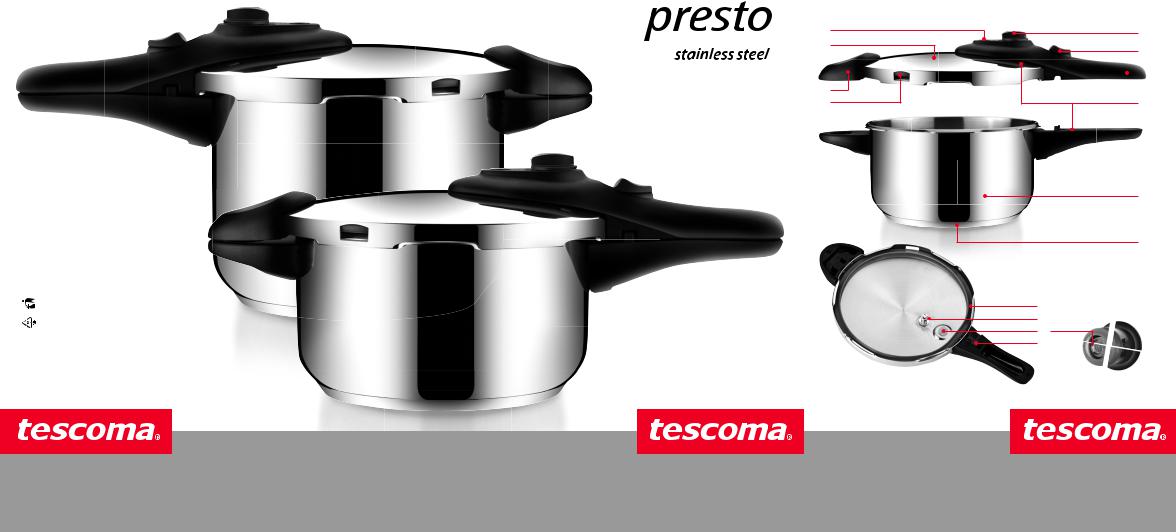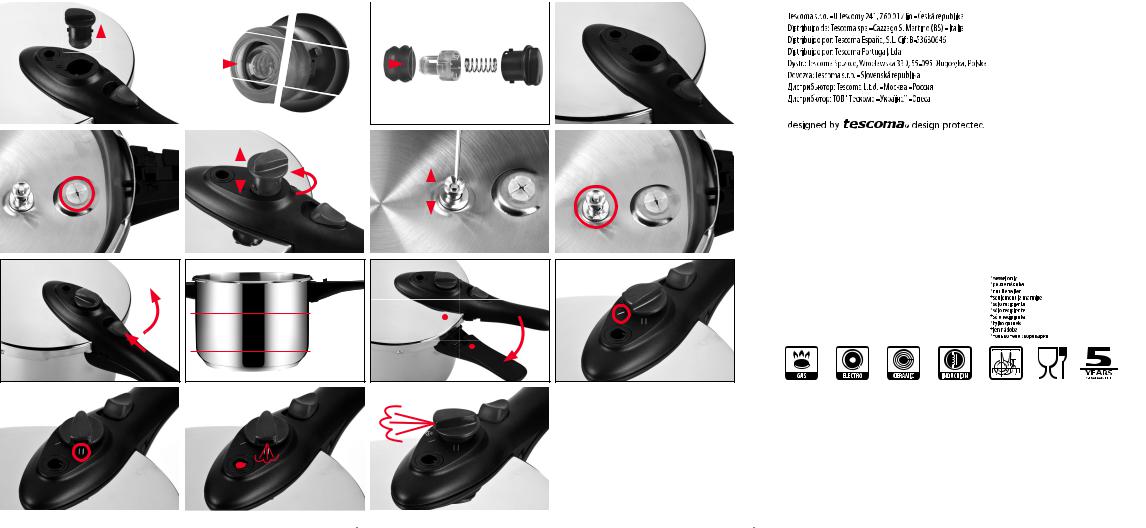Tescoma Presto 4 l, Presto Duo 4 + 6 l User Manual

© 2010 Tescoma
3
5
Pressure cooker / Tlakový hrnec |
12 |
|
Schnellkochtopf / Marmite à pression |
||
9 |
||
Pentola a pressione / Olla a presión |
||
|
||
Panela de pressão / Szybkowar |
|
|
Tlakový hrniec / Скороварка |
|
10
3
2
4
Instructions for use / Návod k použití / Gebrauchsanleitung / Mode d‘emploi
Istruzioni per l‘uso / Instrucciones de uso / Instruções de utilização
Instrukcja użytkowania / Návod na použitie / Инструкция по использованию
1
7
 6 8
6 8
11
13

|
A |
|
|
|
B |
|
|
C |
D |
|
|
|
|
|
|
|
|
|
|
|
|
|
|
|
|
|
|
|
|
|
|
|
|
|
|
|
|
|
|
|
|
|
|
|
|
|
|
|
|
E |
|
|
F |
|
|
G |
|
H |
|
|
|
|
|
|
|
|
|
|
|
|
|
|
|
|
|
|
|
|
|
|
|
|
|
|
|
|
|
|
|
|
|
|
|
|
|
|
|
|
|
|
|
|
|
J |
K |
L |
M |
max. 2/3
min. 250 ml
N |
|
O |
|
P |
|
|
|
|
|
|
|
|
|
|
|
|
|
|
|
|
|
|
|
|
|
|
|
|
|
|
|
|
|
|
|
|
|
|
|

Instructions for use |
2 |
Návod k použití |
10 |
Gebrauchsanleitung |
18 |
Mode d‘emploi |
26 |
Istruzioni per l‘uso |
34 |
Instrucciones de uso |
42 |
Instruções de utilização |
50 |
Instrukcja użytkowania |
58 |
Návod na použitie |
66 |
Инструкция по использованию |
74 |

Pressure cooker PRESTO
We congratulate you on the purchase of this Tescoma product. Thank you for buying Tescoma. If needed, please contact your retailer or Tescoma at www.tescoma.com.
CHARACTERISTICS
The PRESTO pressure cooker enables cooking at low or high pressure*, which contributes to preserving the natural taste and nutritional value of meals.
Cooking with the PRESTO pressure cooker is significantly faster than standard cooking.
The PRESTO pressure cooker is made of high-grade stainless steel; it has solid handles of high-quality resistant plastics that do not burn if used properly.
The solid three-layer sandwich bottom has excellent heat retaining properties that help to economise on energy. Cooking takes place at a low heat output; the heat may be switched off in advance before the end of cooking.
The pressure cooker is provided with 3 safety cut-outs and a lock against accidental opening; it is entirely safe to use.
The PRESTO pressure cooker is suitable for all types of cooker: gas, electric, vitro-ceramic and induction cookers.
* OPERATING PRESSURES IN THE PRESTO PRESSURE COOKER
The operating pressure in the vessel is 0.65 bar when cooking at low pressure. The operating pressure in the vessel is 1.05 bar when cooking at high pressure.
PRESSURE COOKER DESCRIPTION
1.Pressure regulator
2.Operating valve
3.Safety valve with pressure indicator
4.Lock against accidental opening
5.Lid of the pressure cooker
6.Lid handle
7.Button for opening the lid
8.Marks for closing the lid
9.Pressure cut-out – aperture in the rim of the lid
10.Silicone seal
11.Pressure cooker vessel
12.Grips
13.Sandwich bottom
2

BEFORE FIRST USE
Thoroughly study these instructions for use before the first use. Wash the pressure cooker and all its parts with warm water and detergent and wipe dry.
BEFORE EACH USE
Inspecting the valves
Pressure regulator and operating valve
Turn the pressure regulator to the position for removal from the lid (symbol) and remove it. (A)
NOTICE: Do not set the pressure regulator to the position for removal from the lid and do not remove it while the vessel is pressurised.
Push on the operating valve in the bottom part of the regulator – make sure that it is not clogged and that it springs. (B)
If this is not the case, remove the operating valve and disassemble it into individual parts, flush under running water and assemble the operating valve again. (C)
Check the aperture for the pressure regulator in the lid of the pressure cooker – it must be clean, not clogged. If clogged, flush it under running water or clean using a suitable object. (D)
Make sure that the silicone seal in the aperture for the pressure regulator in the lid is properly positioned. Position it properly if needed. (E)
Attach the pressure regulator with the operating valve back to the lid handle after inspecting it, set to position for releasing steam and make sure that the pressure regulator freely travels up and down, i. e. it springs and can be easily set to the low and high pressure positions. (F)
Safety valve
Push on the centre of the safety valve in the bottom of the lid – it must spring, and check if the entire safety valve freely travels in the lid. (G)
Check if the nut of the safety valve is tight enough in the bottom of the lid; if not, tighten the nut. (H)
USE
Opening the pressure cooker
Push on the button for opening on the handle towards the centre of the lid, turn the lid counterclockwise and remove it from the vessel. (J)
NEVER APPLY INAPPROPRIATE FORCE WHEN OPENING THE PRESSURE COOKER.
Filling the pressure cooker
FOR SAFETY REASONS, THE PRESSURE COOKER MUST BE FILLED TO A MAXIMUM OF 2/3 VESSEL CAPACITY.
With foods that tend to froth or swell when heated, such as soups or lentils, rice, etc., fill the pressure cooker to a maximum of 1/3 vessel capacity to avoid unwanted clogging of valves and overboiling. (K)
DO NOT COOK WITHOUT WATER IN THE PRESSURE COOKER. THE MINIMUM AMOUNT OF WATER IS 250 ML.
Closing the pressure cooker
Place the lid of the pressure cooker onto the vessel so that the round marks on the lid and on the handle of the vessel point towards each other. Turn the lid clockwise so that the grips and the handles are aligned. (L) Make sure that the pressure regulator can be easily set to low and high pressure positions.
DO NOT APPLY INAPPROPRIATE FORCE WHEN CLOSING THE PRESSURE COOKER.
3

Cooking in the pressure cooker
SELECT LOW OR HIGH PRESSURE BY SETTING THE PRESSURE REGULATOR TO THE RELEVANT POSITION.
1.If you wish to cook at a low pressure, turn the pressure regulator to the right to the  position. Cooking at a low pressure is ideal for economic cooking of meals; for example for cooking vegetables, fruits, fish, etc. (M)
position. Cooking at a low pressure is ideal for economic cooking of meals; for example for cooking vegetables, fruits, fish, etc. (M)
2.If you wish to cook at a high pressure, turn the operating valve to the left to the  position. Cooking at a high pressure is quicker and uses a higher temperature. It is suitable in particular for cooking meat and meals that require longer thermal treatment. (N)
position. Cooking at a high pressure is quicker and uses a higher temperature. It is suitable in particular for cooking meat and meals that require longer thermal treatment. (N)
3.NOTICE: Set the pressure regulator exclusively to the positions intended for low and high pressures; never leave it between these two positions.
4.Place the correctly filled and closed pressure cooker with the selected pressure onto a cooker set to the highest output.
5.The red pressure indicator will slip upwards after a short while. This means that the minimum pressure has built up in the vessel and the pressure cooker can no longer be opened – steam will begin to escape from the aperture in the pressure regulator after a while (O).
6.When steam begins to escape from the aperture in the pressure regulator, reduce the heat output so that only a small amount of steam escapes from the aperture in the pressure regulator.
7.We do not recommend changing the low/high pressure setting while cooking.
8.If this is necessary, use a kitchen mitten to control pressure during the cooking process!
WARNING! A MINUTE AMOUNT OF STEAM MAY ALSO ESCAPE BELOW THE HANDLE OF THE LID DURING THE COOKING PROCESS.
NOTICE
If a large amount of steam escapes from the pressure cooker at the beginning of the cooking process, the pressure cooker has not been correctly closed. Incorrect closing is usually due to the following:
a)The lid is attached incorrectly – close the pressure cooker again.
b)The pressure regulator is set to the steam release position – set it to the low or high pressurecooking position.
c)The silicone seal is incorrectly positioned in the lid – check its position.
d)The silicone seal is faulty – replace it with a new original Tescoma seal.
If no steam escapes from the pressure cooker at the beginning of the cooking process, check whether the pressure regulator is set to the position between low and high pressure. If yes, set it to the operating position for low or high pressure.
Cooking termination, steam releasing and opening of the pressure cooker
ALWAYS RELEASE STEAM ONLY AFTER REMOVING THE PRESSURE COOKER FROM THE HEAT.
After the time required for cooking your meal elapses, remove the pressure cooker from the heat source even if the latter has already been switched off.
Set the pressure cooker aside for a while to allow the temperature and pressure in the pressure cooker to drop sufficiently.
Then set the pressure regulator to the steam release position and release all steam from the pressure cooker. (P)
4

The pressure indicator will slip down automatically after the steam has been entirely released and the pressure has dropped; it will release the lock against accidental opening and the pressure cooker can now be opened.
If the pressure indicator remains in the upper position after releasing steam and the pressure cooker cannot be opened, this means that there is still pressure in the vessel. Repeatedly push on the pressure regulator using an oven mitten and wait until all steam escapes from the pressure cooker.
If the pressure indicator does not slip in automatically even after the steam has been released and the pressure cooker still cannot be opened, place the pressure cooker into the sink and cool the lid with a small amount of slowly running cold water until the pressure indicator slips in.
Then open the pressure cooker and thoroughly inspect and clean the operating valve and the safety valve before further use.
NEVER COOL THE PRESSURE COOKER ABRUPTLY UNDER RUNNING WATER, DO NOT LET WATER RUN ONTO PLASTIC PARTS AND DO NOT IMMERSE THE ENTIRE PRESSURE COOKER IN WATER.
SAFETY CUT-OUTS
Operating valve
The operating valve controls the high and low pressure, continuously releases excess steam and releases all steam from the pressure cooker at the end of cooking.
Safety valve
The safety valve operates as a cut-out activated when the operating valve becomes clogged. Immediately remove the pressure cooker from the heat source if steam ceases to escape from the operating valve and starts to escape intensely from the safety valve during the cooking process. After the pressure cooker cools down, open it and clean the operating valve.
Aperture in the rim of the lid
If the operating valve and the safety valve become clogged at once, the pressure in the pressure cooker pushes the silicone seal through the aperture in the rim of the lid, which causes an immediate drop in pressure and steam release.
Warning! When cooking with the pressure cooker, make sure that the aperture in the rim of the lid is not directed towards individuals coming near the pressure cooker.
IF THE SILICONE SEAL IS PUSHED THROUGH THE APERTURE IN THE RIM OF THE LID, DO NOT REPAIR THE PRESSURE COOKER YOURSELF; INSTEAD BRING IT IN FOR PROFESSIONAL SERVICING.
Lock against accidental opening
Prevents accidental opening of the pressure cooker until all steam has escaped from the vessel and pressure drops entirely.
PRACTICAL HINTS
ALWAYS USE AN APPROPRIATE SIZE OF COOKING RANGE OR FLAME FOR COOKING.
The diameter of the cooking range must be identical or smaller than the diameter of the bottom of the pressure cooker! Flame must never expand beyond the bottom of the pressure cooker. Use the dispenser net or cooking range when cooking on gas.
Make use of the heat retaining properties of the three-layer sandwich bottom. Switch the heat off in advance before the end of cooking. Thanks to the three-layer sandwich bottom, the accumulated heat energy is transferred into the pressure cooker even after the heat has been switched off.
5

The vessel of the pressure cooker may also be used without the lid as a traditional pot for cooking meals on the cooking range.
STORAGE, MAINTENANCE AND CLEANING
Lid
DO NOT WASH THE LID OF THE PRESSURE COOKER IN DISHWASHER.
Clean the operating valve aperture by flushing it with running water or clean it using a suitable object.
Clean the safety valve by repeatedly pushing on the centre and lightly pulling the entire valve upwards under running water.
Do not disassemble the safety valve, the grips or any other parts of the lid except for the operating valve during its cleaning.
ALWAYS STORE THE PRESSURE COOKER WITH THE LID UNATTACHED.
Vessel
THE VESSEL OF THE PRESSURE COOKER IS DISHWASHER SAFE.
Should white stains due to scale formation appear inside the pressure cooker, use vinegar, lemon drops or the special stainless steel cleaning agent CLINOX to clean them. The white stains do not affect functioning of the cookware and are not hazardous to health. As such they do not represent a fault and cannot be claimed. When the cooker is overheated, purple to brown stains might appear on the surface. These stains do not affect correct functioning of the cookware and are not hazardous to health. As such they do not represent a fault and cannot be claimed.
Never expose the pressure cooker vessel to detergents including water-soluble detergents for prolonged periods of time. Do not store remaining food inside the vessel.
Silicone seal
The pressure cooker seal is made of excellent silicone that lasts for about 500 hours of operation. Remove the seal from the lid after each use of the pressure cooker, wash it and dry, lightly smear with cooking oil or fat and insert back.
If the seal shows any signs of leakage or loss of flexibility, it must be immediately replaced with a new Tescoma brand seal.
If you are not constantly using the pressure cooker, replace the seal regularly at two-year intervals. ALWAYS USE TESCOMA SPARE PARTS.
SAFETY INSTRUCTIONS PURSUANT TO EN 12778
1.Read the INSTRUCTIONS FOR USE thoroughly before first use.
2.Do not leave the pressure cooker unattended during the cooking process and do not use it for any other purposes than cooking foodstuffs.
3.Check the operating valve and the safety valve for proper functioning prior to each use.
4.Handle the pressure cooker with utmost care when cooking; never touch the hot parts.
5.Prevent children coming near the pressure cooker while cooking.
6.Fill the pressure cooker to a maximum of 2/3 vessel capacity; when cooking foods that tend to swell such as rice, lentils, pasta, etc., fill the pressure cooker to a maximum of 1/3 vessel capacity. Shake
6
the closed pressure cooker before opening it when cooking pasta in pressurised environment. Never cook without water.
7.Do not put meals wrapped in fabric, paper or plastic materials into the pressure cooker. Never pierce foods that tend to expand in volume (such as meat with skin, beef tongue, etc.) while the skin is enlarged to avoid scalding.
8.Do not open the pressure cooker without entirely reducing pressure inside the vessel. Never apply force when opening the pressure cooker.
9.Do not put the pressure cooker inside a heated oven and do not use it for frying.
10.Do not intervene in any system within the pressure cooker beyond the Instructions for use – always contact a professional service for repairs and use nothing other than original spare parts.
WARNING! INTENDED FOR HEAT TREATMENT OF FOODS IN A PRESSURISED ENVIRONMENT. IMPROPER USE OR MAINTENANCE CAN CAUSE INJURY.
7

REFERENCE TIMES OF COOKING IN THE PRESTO PRESSURE COOKER
The indicated times of cooking are measured from the moment steam begins to escape from the operating valve. When this happens, set to low heat. All the indicated times are for reference only and depend on the ingredients, their quantity, quality, initial temperature, type of heat source, individual setting of pressure in the pressure cooker, etc. Deviations from the indicated times might occur; you will determine accurate times based on your own experience.
HIGH PRESSURE |
|
MEAT |
time in min |
Beef |
|
Roll |
20-30 |
Roast beef |
30-40 |
Sirloin |
30-40 |
Soup meat |
35-40 |
Tongue |
45 |
Pork |
20 |
Smoked side |
|
Roll |
20-30 |
Boiled pork knuckle |
25-30 |
Roast |
30-35 |
Veal |
12-15 |
Roast |
|
Head |
15 |
Leg |
15-20 |
Tongue |
15-20 |
Lamb and mutton |
30 |
Leg |
|
Poultry |
8-10 |
Squab |
|
Chicken |
15 |
Hen |
15-20 |
Giblets |
15 |
Venison |
15 |
Rabbit |
|
Roasted hare |
15 |
Venison back |
10 |
Hare on pepper |
10-15 |
Venison leg |
20-30 |
CEREALS |
|
Oat and maize |
5 |
Oat flour |
|
Oat flakes |
6 |
Gristles |
6 |
Maize |
10 |
LOW PRESSURE
FISH, FRUITS AND VEGETABLES
Fish |
time in min |
Depending on amount |
6-8 |
Potatoes |
7-9 |
Sliced salted potatoes |
|
Potatoes in their jackets |
10-15 |
Fruit |
2-5 |
Sliced apples |
|
Sliced pears |
2-5 |
Vegetables |
2-3 |
Spinach |
|
Pepper |
3-4 |
Sliced celery |
3-5 |
Sliced garlic |
4 |
Broccoli |
5-6 |
Sterilised beans |
5-6 |
Kohlrabi |
5-6 |
Carrot |
6-8 |
Asparagus |
6-10 |
Sprouts |
8-10 |
Cabbage |
7-12 |
Cut cauliflower |
8-9 |
Red cabbage |
8-10 |
Sauerkraut |
10-12 |
Whole cauliflower |
15-18 |
SOUPS AND LENTILS |
|
Soups |
|
Mushroom soup |
2-5 |
Broth |
25-30 |
Chicken bouillon |
25-30 |
Oxtail |
25-30 |
Lentils |
10-12 |
Soaked peas |
|
Soaked beans |
25-30 |
RICE - LOW PRESSURE |
7-8 |
Rice milk |
|
Risotto |
5-7 |
8

WARRANTY CERTIFICATE
A 5-year warranty period applies to this product from the date of purchase. Present this warranty certificate with a valid purchase receipt. Provision of the warranty does not prejudice the purchaser’s rights applicable to the purchase under the special legal regulations. The warranty period commences on the date of purchase.
Product:
Retailer (trade name and address):
Date of purchase:
Retailer’s stamp and signature:
The warranty does not cover:
-improper use of the product incompatible with the Instructions for use
-unauthorised repairs of and alterations to the product
-anything other than the original spare parts used in the product
-defects resulting from an impact or fall
-everyday wear and tear of the product, with the exception of obvious material defects.
If you feel your complaints are justified, please contact your retailer or a Tescoma servicing centre directly. For a current list of the servicing centres, please refer to www.tescoma.com.
THE MANUFACTURER IS NOT LIABLE FOR ANY DAMAGE DUE TO HANDLING AND USING THE PRESSURE COOKER AT VARIANCE WITH THESE INSTRUCTIONS FOR USE.
9

Tlakový hrnec PRESTO
Blahopřejeme k zakoupení výrobku Tescoma a děkujeme za důvěru projevenou naší značce. V případě potřeby se prosím obraťte na svého prodejce nebo na firmu Tescoma prostřednictvím www.tescoma.com.
CHARAKTERISTIKA
Tlakový hrnec PRESTO umožňuje vaření při nízkém nebo při vysokém tlaku*, což přispívá k zachování přirozené chuti a nutričních hodnot pokrmů.
Vaření v tlakovém hrnci PRESTO probíhá výrazně rychleji než standardní vaření.
Tlakový hrnec PRESTO je vyroben z prvotřídní nerezavějící oceli, rukojeti z kvalitních odolných plastů, které při správném použití nepálí.
Masivní třívrstvé sendvičové dno má vynikající termoakumulační vlastnosti přispívající k úspoře energie. Vaření probíhá při nižším výkonu sporáku, který je možné vypínat s předstihem ještě před ukončením vaření.
Tlakový hrnec je vybaven 3 bezpečnostními tlakovými pojistkami a pojistkou proti nechtěnému otevření, jeho použití je zcela bezpečné.
Tlakový hrnec PRESTO je vhodný pro všechny typy sporáků: plynové, elektrické, sklokeramické a indukční.
* PRACOVNÍ TLAKY V TLAKOVÉM HRNCI PRESTO
Pracovní tlak v nádobě při vaření při nízkém tlaku je 0,65 bar. Pracovní tlak v nádobě při vaření při vysokém tlaku je 1,05 bar.
POPIS TLAKOVÉHO HRNCE
1.Regulátor tlaku
2.Pracovní ventil
3.Bezpečnostní ventil s indikátorem tlaku
4.Pojistka proti nechtěnému otevření
5.Víko tlakového hrnce
6.Rukojeť víka
7.Tlačítko pro otevření víka
8.Značky pro uzavírání víka
9.Tlaková pojistka - otvor v lemu víka
10.Silikonové těsnění
11.Nádoba tlakového hrnce
12.Úchyty
13.Sendvičové dno
10

PŘED PRVNÍM POUŽITÍM
Před prvním použitím si důkladně prostudujte tento návod. Tlakový hrnec a všechny jeho části omyjte teplou vodou s přídavkem saponátu a vytřete do sucha.
PŘED KAŽDÝM POUŽITÍM
Kontrola ventilů
Regulátor tlaku a pracovní ventil
Regulátor tlaku pootočte do polohy určené pro vyjmutí z víka (symbol) a vyjměte jej. (A)
UPOZORNĚNÍ: Regulátor tlaku nenastavujte do polohy pro vyjmutí z víka a nevyjímejte jej, dokud je v nádobě tlak.
Zatlačte na pracovní ventil ve spodní části regulátoru – ujistěte se, že je nezanesený a pruží. (B)
V případě, že tomu tak není, vyjměte a rozložte pracovní ventil na jednotlivé části, propláchněte je pod proudem vody a pracovní ventil znovu sestavte. (C)
Zkontrolujte otvor pro regulátor tlaku ve víku tlakového hrnce – musí být čistý, nezanesený. V případě zanesení jej propláchněte pod proudem vody nebo pročistěte vhodným předmětem. (D)
Zkontrolujte, zda je silikonové těsnění v otvoru regulátoru tlaku ve víku správně usazeno. V případě potřeby jej správně usaďte. (E)
Po kontrole nasaďte regulátor tlaku s pracovním ventilem zpět do rukojeti víka, nastavte do polohy pro vypouštění páry a ujistěte se, že se volně pohybuje nahoru a dolů – pruží a lze jej snadno nastavit do polohy pro nízký i pro vysoký tlak. (F)
Bezpečnostní ventil
Zatlačte na střed bezpečnostního ventilu ve spodní části víka – musí pružit a ověřte, že se celý bezpečnostní ventil volně pohybuje ve víku.(G)
Zkontrolujte, zda je matice bezpečnostního ventilu ve spodní části víka pevně utažena, pokud tomu tak není, matici dotáhněte. (H)
POUŽITÍ
Otevírání tlakového hrnce
Zatlačte na tlačítko otevírání na rukojeti směrem ke středu víka, otočte víkem proti směru hodinových ručiček a sejměte jej z nádoby. (J)
PŘI OTEVÍRÁNÍ TLAKOVÉHO HRNCE NIKDY NEPOUŽÍVEJTE NEPŘIMĚŘENOU SÍLU.
Plnění tlakového hrnce
TLAKOVÝ HRNEC LZE Z BEZPEČNOSTNÍCH DŮVODŮ PLNIT MAXIMÁLNĚ DO 2/3 OBJEMU NÁDOBY.
U jídel, která během tepelného zpracování pění nebo bobtnají, např. polévky nebo luštěniny, rýže apod., plňte hrnec maximálně do 1/3 objemu nádoby, abyste zabránili nežádoucímu zanesení ventilů a překypění. (K)
V TLAKOVÉM HRNCI NEVAŘTE BEZ POUŽITÍ VODY. MINIMÁLNÍ MNOŽSTVÍ VODY JE 250 ml.
Uzavírání tlakového hrnce
Víko tlakového hrnce položte na nádobu tak, aby kulaté značky na víku a na rukojeti nádoby směřovaly proti sobě. Otočte po směru hodinových ručiček, aby se úchyty a rukojeti kryly. (L) Zkontrolujte, že lze regulátor tlaku snadno nastavit do polohy pro nízký i pro vysoký tlak.
PŘI UZAVÍRÁNÍ HRNCE NEPOUŽÍVEJTE NEPŘIMĚŘENOU SÍLU.
11

Vaření v tlakovém hrnci
NÍZKÝ NEBO VYSOKÝ TLAK ZVOLTE NASTAVENÍM REGULÁTORU TLAKU DO PŘÍSLUŠNÉ POLOHY.
1.Pokud si přejete vařit při nízkém tlaku, otočte regulátor tlaku doprava do polohy  . Vaření při nízkém tlaku je ideální pro šetrnou tepelnou úpravu pokrmů, např. při vaření zeleniny, ovoce, luštěnin, ryb apod. (M)
. Vaření při nízkém tlaku je ideální pro šetrnou tepelnou úpravu pokrmů, např. při vaření zeleniny, ovoce, luštěnin, ryb apod. (M)
2.Pokud si přejete vařit při vysokém tlaku, otočte pracovní ventil doleva do polohy  . Vaření při vysokém tlaku je rychlejší a probíhá při vyšší teplotě. Hodí se zejména k přípravě masa a pokrmů, které vyžadují delší tepelné zpracování. (N)
. Vaření při vysokém tlaku je rychlejší a probíhá při vyšší teplotě. Hodí se zejména k přípravě masa a pokrmů, které vyžadují delší tepelné zpracování. (N)
3.UPOZORNĚNÍ: Regulátor tlaku nastavujte výhradně do polohy předepsané pro nízký nebo vysoký tlak, nikdy jej neponechávejte v mezipoloze mezi těmito dvěma stupni.
4.Správně naplněný a uzavřený hrnec se zvoleným tlakem postavte na sporák nastavený na nejvyšší stupeň.
5.Po krátké chvíli se červený indikátor tlaku vysune nahoru. To znamená, že se v nádobě vytvořil minimální tlak a tlakový hrnec již nelze otevřít – pára začne po chvíli unikat z otvoru v regulátoru tlaku (O).
6.Jakmile začne pára unikat z otvoru v regulátoru tlaku, snižte výkon sporáku tak, aby z otvoru regulátoru ucházelo jen malé množství páry.
7.Měnit nastavení nízkého nebo vysokého tlaku během vaření nedoporučujeme.
8.Pokud je to nutné, použijte při regulaci tlaku během vaření kuchyňskou rukavici!
POZOR! V PRŮBĚHU VAŘENÍ MŮŽE NEPATRNÉ MNOŽSTVÍ PÁRY UNIKAT TÉŽ POD RUKOJETÍ VÍKA.
UPOZORNĚNÍ
Pokud na počátku vaření z tlakového hrnce uniká velké množství páry, není tlakový hrnec správně uzavřen. Nesprávné uzavření je obvykle způsobeno:
a)Víko není správně nasazeno – zopakujte uzavření hrnce.
b)Regulátor tlaku je nastavený v poloze pro vypouštění páry – nastavte jej do polohy pro vaření při nízkém nebo vysokém tlaku.
c)Silikonové těsnění není správně osazeno ve víku – zkontrolujte jeho umístění.
d)Silikonové těsnění je poškozeno – vyměňte jej za nové originální těsnění značky Tescoma.
Pokud na počátku vaření z tlakového hrnce neuniká žádná pára, zkontrolujte, zda není regulátor tlaku nastaven do mezipolohy mezi nízkým a vysokým tlakem. Pokud tomu tak je, nastavte jej do pracovní polohy pro nízký nebo vysoký tlak.
Ukončení vaření, vypouštění páry a otevírání tlakového hrnce
PÁRU Z TLAKOVÉHO HRNCE VYPOUŠTĚJTE VŽDY AŽ PO JEHO ODSTAVENÍ ZE SPORÁKU.
Po uplynutí doby potřebné k uvaření pokrmů sejměte tlakový hrnec ze sporáku, a to i v případě, že je sporák již vypnutý.
Tlakový hrnec ponechte chvíli odstavený, aby teplota a tlak v hrnci dostatečně poklesly.
Poté nastavte regulátor tlaku do polohy pro vypouštění páry a z tlakového hrnce vypusťte veškerou páru. (P)
Indikátor tlaku se po úplném vypuštění páry a snížení tlaku sám zasune dolů, uvolní pojistku proti nechtěnému otevření a tlakový hrnec je možné otevřít.
12

Pokud indikátor tlaku zůstává po vypuštění páry vysunutý v horní poloze a tlakový hrnec nelze otevřít, znamená to, že je v nádobě stále tlak. S použitím kuchyňské rukavice opakovaně zatlačte na regulátor tlaku a vyčkejte, dokud všechna pára z hrnce neunikne.
Jestliže se indikátor tlaku ani po vypuštění páry sám nezasune a tlakový hrnec nelze nadále otevřít, vložte tlakový hrnec do dřezu a ochlaďte víko malým množstvím pomalu stékající studené vody, dokud se indikátor tlaku nezasune.
Poté tlakový hrnec otevřete a před dalším použitím důkladně zkontrolujte a pročistěte pracovní i bezpečnostní ventil.
TLAKOVÝ HRNEC POD TEKOUCÍ VODOU NIKDY NEOCHLAZUJTE ZPRUDKA, VODU NENECHTE STÉKAT NA PLASTOVÉ ČÁSTI A HRNEC NENOŘTE DO VODY CELÝ.
BEZPEČNOSTNÍ POJISTKY
Pracovní ventil
Pracovní ventil reguluje nízký a vysoký tlak, průběžně vypouští přebytečnou páru a po ukončení vaření vypouští z hrnce veškerou páru.
Bezpečnostní ventil
Bezpečnostní ventil funguje jako pojistka při zanesení pracovního ventilu. V případě, že během vaření pára přestane unikat z pracovního ventilu a začne intenzivně unikat z bezpečnostního ventilu, hrnec ihned odstavte. Po vychladnutí tlakový hrnec otevřete a vyčistěte pracovní ventil.
Otvor v lemu víka
Pokud dojde k zanesení pracovního i bezpečnostního ventilu současně, tlak v hrnci vytlačí silikonové těsnění otvorem v lemu víka, čímž dojde k okamžitému snížení tlaku a úniku páry.
Pozor! Tlakový hrnec během vaření používejte tak, aby otvor v lemu víka nebyl nasměrován proti osobám v blízkosti tlakového hrnce.
POKUD DOJDE K PROTLAČENÍ SILIKONOVÉHO TĚSNĚNÍ OTVOREM V LEMU VÍKA, TLAKOVÝ HRNEC SAMI NEOPRAVUJTE, ALE PŘEDEJTE JEJ DO ODBORNÉHO SERVISU.
Pojistka proti nechtěnému otevření
Zabraňuje nechtěnému otevření tlakového hrnce, dokud z nádoby neunikne všechna pára a nedojde k úplnému snížení tlaku.
PRAKTICKÁ DOPORUČENÍ
K VAŘENÍ VOLTE VŽDY ODPOVÍDAJÍCÍ VELIKOST PLOTÝNKY NEBO PLAMENE.
Průměr plotýnky musí být stejný nebo menší než je průměr dna hrnce! Plamen nesmí nikdy přesahovat okraje dna hrnce. Při vaření na plynu používejte rozptylovací síťku nebo varnou plotýnku.
Využívejte termoakumulačních vlastností třívrstvého sendvičového dna. Sporák vypínejte s předstihem ještě před ukončením vaření. Díky třívrstvému sendvičovému dnu je akumulovaná tepelná energie předávána do hrnce i po vypnutí sporáku.
Nádobu tlakového hrnce bez víka je možné využít i jako klasický hrnec pro přípravu pokrmů na plotně sporáku.
13

SKLADOVÁNÍ, ÚDRŽBA a ČIŠTĚNÍ
Víko
VÍKO TLAKOVÉHO HRNCE NEMYJTE V MYČCE NÁDOBÍ.
Otvor pracovního ventilu čistěte propláchnutím pod proudem vody, případně jej vyčistěte vhodným nástrojem.
Bezpečnostní ventil vyčistěte opakovaným zatlačením na střed a povytažením celého ventilu pod tekoucí vodou.
Pracovní ani bezpečnostní ventil, úchyty ani jiné části víka s výjimkou pracovního ventilu nedemontujte. TLAKOVÝ HRNEC SKLADUJTE VŽDY S NENASAZENÝM VÍKEM.
Nádoba
NÁDOBU TLAKOVÉHO HRNCE LZE MÝT V MYČCE NÁDOBÍ.
Objeví-li se uvnitř hrnce bílé usazeniny vodního kamene, vyčistěte je octem, několika kapkami citronu nebo speciálním prostředkem na čištění nerezového nádobí CLINOX. Bílé skvrny nijak neomezují funkčnost či zdravotní nezávadnost nádobí, nejsou vadou výrobku a nemohou být předmětem reklamace. Při přehřátí hrnce se na povrchu může objevit fialové až hnědé zabarvení. Toto zabarvení neomezuje funkčnost či zdravotní nezávadnost hrnce, není vadou výrobku a nemůže být předmětem reklamace.
Na nádobu tlakového hrnce nenechávejte nikdy dlouhodobě působit saponáty, a to ani vodou ředěné. Uvnitř nádoby neskladujte zbytky pokrmů.
Silikonové těsnění
Těsnění tlakového hrnce je vyrobeno z prvotřídního silikonu a vydrží cca 500 hodin provozu. Po každém použití tlakového hrnce vyjměte těsnění z víka, umyjte jej, osušte, potřete lehce potravinářským olejem nebo tukem a vložte zpět.
Pokud těsnění vykazuje jakékoliv známky netěsnosti nebo ztrátu pružnosti, je třeba jej okamžitě vyměnit za nové těsnění značky Tescoma.
Pokud tlakový hrnec nepoužíváte intenzivně, měňte těsnění pravidelně v dvouletých cyklech. POUŽÍVEJTE ZÁSADNĚ NÁHRADNÍ DÍLY ZNAČKY TESCOMA.
BEZPEČNOSTNÍ POKYNY DLE EN 12778
1.Před prvním použitím si důkladně prostudujte NÁVOD K OBSLUZE.
2.Tlakový hrnec nenechávejte během vaření bez dozoru a nepoužívejte jej pro jiné účely, než k vaření potravin.
3.Před každým použitím zkontrolujte funkčnost pracovního a bezpečnostního ventilu.
4.Během vaření manipulujte s tlakovým hrncem s maximální opatrností, nikdy se nedotýkejte jeho horkých částí.
5.Zamezte dětem v přístupu do blízkosti tlakového hrnce během vaření.
6.Tlakový hrnec plňte maximálně do 2/3 objemu nádoby, při přípravě pokrmů, které vařením bobtnají, jako jsou rýže, luštěniny, těstoviny apod., plňte tlakový hrnec max. do 1/3 objemu nádoby. Při vaření těstovin pod tlakem uzavřeným hrncem po úplném snížení tlaku před otevřením zatřeste. Nikdy nevařte bez použití vody.
7.Do tlakového hrnce nevkládejte jídla zabalená do tkaniny, papíru nebo plastikových obalů. Pokrmy, u kterých dochází ke zvětšení objemu (např. maso s kůží, hovězí jazyk apod.), nikdy nepropichujte, dokud je kůže nabobtnalá – nebezpečí opaření.
14
8.Tlakový hrnec neotvírejte, aniž byste zcela snížili tlak uvnitř nádoby. Nikdy při otvírání hrnce nepoužívejte sílu.
9.Tlakový hrnec nedávejte do vyhřáté pečící trouby a nepoužívejte ke smažení.
10.Nezasahujte do žádného systému hrnce nad rámec Návodu k použití – opravu svěřte vždy odbornému servisu, nikdy nepoužívejte jiné, než originální náhradní díly.
POZOR! SLOUŽÍ K TEPELNÉ ÚPRAVĚ POKRMŮ POD TLAKEM. NESPRÁVNÉ POUŽITÍ NEBO ÚDRŽBA MOHOU ZPŮSOBIT PORANĚNÍ.
15

ORIENTAČNÍ ČASY PRO VAŘENÍ V TLAKOVÉM HRNCI PRESTO
Uvedené doby vaření jsou měřeny od okamžiku, kdy z pracovního ventilu začne unikat pára. V tom okamžiku přepněte sporák na nízký výkon. Všechny uvedené časy jsou pouze orientační a jsou závislé na druhu připravovaných surovin, jejich množství, kvalitě, výchozí teplotě, typu sporáku, individuálním nastavení tlaku v hrnci apod. Odchylky od uvedených časů nejsou vyloučeny, přesné časy stanovíte na základě vlastních zkušeností.
VYSOKÝ TLAK |
|
MASO |
čas v min. |
Hovězí maso |
|
Roláda |
20-30 |
Pečeně |
30-40 |
Svíčková |
30-40 |
Polévkové maso |
35-40 |
Jazyk |
45 |
Vepřové maso |
20 |
Uzený bůček |
|
Roláda |
20-30 |
Ovarové kolínko |
25-30 |
Pečeně |
30-35 |
Telecí maso |
12-15 |
Pečeně |
|
Hlava |
15 |
Nožička |
15-20 |
Jazyk |
15-20 |
Jehněčí a skopové maso |
30 |
Kýta |
|
Drůbeží maso |
8-10 |
Holoubě |
|
Kuře |
15 |
Slepice |
15-20 |
Husí drůbky |
15 |
Zvěřina |
15 |
Králík |
|
Zaječí pečeně |
15 |
Srnčí hřbet |
10 |
Zaječí na pepři |
10-15 |
Srnčí kýta |
20-30 |
OBILOVINY |
|
Oves a kukuřice |
5 |
Ovesná mouka |
|
Ovesné vločky |
6 |
Ovesná krupice |
6 |
Kukuřice |
10 |
NÍZKÝ TLAK |
|
RYBY, OVOCE A ZELENINA |
čas v min. |
Ryby |
|
Dle velikosti porce |
6-8 |
Brambory |
7-9 |
Brambory krájené solené |
|
Brambory ve slupce |
10-15 |
Ovoce |
2-5 |
Jablka krájená |
|
Hrušky krájené |
2-5 |
Zelenina |
2-3 |
Špenát |
|
Paprika |
3-4 |
Celer krájený |
3-5 |
Česnek krájený |
4 |
Brokolice |
5-6 |
Zavařené fazole |
5-6 |
Kedlubny |
5-6 |
Mrkev |
6-8 |
Chřest |
6-10 |
Růžičková kapusta |
8-10 |
Hlávkové zelí |
7-12 |
Květák dělený |
8-9 |
Červené zelí |
8-10 |
Kysané zelí |
10-12 |
Květák celý |
15-18 |
POLÉVKY A LUŠTĚNINY |
|
Polévky |
2-5 |
Houbová |
|
Masový vývar |
25-30 |
Slepičí vývar |
25-30 |
Volská oháňka |
25-30 |
Luštěniny |
10-12 |
Namočený hrách |
|
Namočené fazole |
25-30 |
RÝŽE |
7-8 |
Rýžová kaše |
|
Rizoto |
5-7 |
16

ZÁRUČNÍ LIST
Na tento výrobek je poskytována záruční doba 5 roků ode dne prodeje. Tento záruční list předkládejte s platným potvrzením o zakoupení výrobku. Poskytnutím záruky nejsou dotčena práva kupujícího, která se ke koupi věci váží podle zvláštních právních předpisů. Záruční doba začíná dnem prodeje.
Výrobek:
Prodejce (obchodní název a adresa):
Datum prodeje:
Razítko a podpis prodejce:
Záruka se zásadně nevztahuje na tyto případy:
-výrobek byl používán v rozporu s Návodem k obsluze
-na výrobku byly provedeny neautorizované opravy a změny
-na výrobku byly použity jiné než originální náhradní díly
-závady byly způsobeny úderem či pádem
-výrobek byl opotřebován běžným užíváním, kromě zjevných materiálových vad.
Oprávněnou reklamaci uplatňujte u prodejce, u kterého jste výrobek zakoupili nebo přímo v servisních střediscích Tescoma. Aktuální seznam servisních středisek na www.tescoma.com.
VÝROBCE NEODPOVÍDÁ ZA JAKÉKOLIV ŠKODY ZPŮSOBENÉ MANIPULACÍ A POUŽITÍM TLAKOVÉHO HRNCE V ROZPORU S TÍMTO NÁVODEM K POUŽITÍ.
17

Schnellkochtopf PRESTO
Wir gratulieren Ihnen zum Kauf des Produktes Tescoma und danken für Ihr in unsere Marke gezeigtes Vertrauen. Im Bedarfsfall wenden Sie sich bitte an Ihren Händler, bzw. na die Firma Tescoma über www.tescoma.com.
BESCHREIBUNG
Im Schnellkochtopf PRESTO kann man beim niedrigen oder hohen Druck* kochen, was zur Erhaltung des natürlichen Geschmacks sowie des Nährwertes der Speisen beiträgt.
Das Kochen im Schnellkochtopf PRESTO erfolgt erheblich schneller als der übliche Kochvorgang.
Der Schnellkochtopf PRESTO ist aus erstklassigem rostfreien Edelstahl hergestellt, die Griffen aus hochwertigen festen Kunststoffen. Beim richtigen Gebrauch werden die Griffe nicht heiß.
Der massive dreischichtige Sandwich-Boden hat ausgezeichnete Wärmeleit-Eigenschaften, die Energieersparnis bringen. Das Kochen erfolgt bei der niedrigeren Leistungsstufe des Kochherdes, der ausgeschaltet werden kann, bevor das Gargut fertig gekocht ist.
Der Schnellkochtopf ist mit drei Drucksicherungen ausgestattet sowie mit der Sicherung gegen unbeabsichtigtes Öffnen, der Kochvorgang ist voll betriebssicher.
Der Schnellkochtopf Tescoma PRESTO ist für sämtliche Herdarten geeignet: Gas-, Elektro-, glaskeramische sowie Induktionsherde.
* ARBEITSDRUCKE IM SCHNELLKOCHTOPF PRESTO
Der Arbeitsdruck im Kochgefäß beim Kochen beim niedrigen Druck beträgt 0,65 bar. Der Arbeitsdruck im Kochgefäß beim Kochen beim hohen Druck beträgt 1,05 bar.
BESCHREIBUNG DES SCHNELLKOCHTOPFES
1.Druckregler
2.Arbeitsventil
3.Sicherheitsventil mit Druckanzeige
4.Sicherung gegen unbeabsichtigtes Öffnen
5.Deckel des Schnellkochtopfes
6.Deckelgriff
7.Knopf zum Öffnen des Deckels
8.Markierungen zum Schließen des Deckels
9.Drucksicherung – Loch im Deckelrand
10.Silikon-Dichtung
11.Kochgefäß
12.Griffe
13.Sandwich-Boden
18

VOR DEM ERSTEN GEBRAUCH
Vor dem ersten Gebrauch sorgfältig die Gebrauchsanleitung durchlesen. Den Schnellkochtopf und sämtliche Teile gründlich mit warmem Wasser mit Reinigungsmittel abwaschen und trockenwischen.
VOR JEDEM GEBRAUCH
Überprüfung der Ventile Druckregler und Arbeitsventil
Den Druckregler in die linke Position für Herausnehmen aus dem Deckel (symbol) drehen und abnehmen.
(A)
HINWEIS: Den Druckregler weder in die Position für das Herausnehmen drehen noch abnehmen, wenn das Kochgefäß unter Druck steht.
Das Arbeitsventil im unteren Teil des Druckreglers andrücken – auf Verstopfung und auf Federung überprüfen. (B).
Im Falle der Verschmutzung das Arbeitsventil herausnehmen, zerlegen, unter fließendem Wasser durchspülen und wieder zusammenlegen. (C)
Das Loch für den Druckregler im Deckel des Schnellkochtopfes überprüfen – es muss sauber, unverstopft sein. Im Falle der Verstopfung unter fließendem Wasser durchspülen, bzw. mit einem geeigneten Gegenstand reinigen. (D)
Die Silikon-Dichtung im Loch des Druckreglers im Deckel auf richtige Sitzung überprüfen, ggf. richtig sitzen.
(E)
Nach der Überprüfung den Druckregler mit Arbeitsventil wieder im Deckelgriff aufsetzen, in die Position für Dampfaustritt einstellen und überprüfen darauf, dass er frei beweglich nach oben und nach unten ist und dass es in die Niederdruck-/Hochdruck-Position leicht einstellbar ist. (F)
Sicherheitsventil
Auf der Unterseite des Deckel die Mitte des Sicherheitsventils drücken – das federbelastete Sicherheitsventil auf freie Beweglichkeit im Deckel überprüfen. (G)
Überprüfen Sie, ob die Befestigungsmutter des Sicherheitsventils auf der Unterseite des Deckels festgezogen ist; anderenfalls die Mutter gut anziehen. (H)
GEBRAUCH
Öffnen des Schnellkochtopfes
Den Knopf am Griff zum Öffnen des Deckels in die Mitte des Deckels andrücken, den Deckel gegen den Uhrzeigersinn umdrehen und vom Topf abnehmen. (J)
DEN SCHNELLKOCHTOPF NIE GEWALTSAM ÖFFNEN.
Befüllen des Schnellkochtopfes
AUS DEN SICHERHEITSGRÜNDEN KANN MAN DEN SCHNELLKOCHTOPF MAX. ZU 2/3 DES TOPFVOLUMENS BEFÜLLEN.
Bei den Gerichten, die beim Kochen schäumen oder quellen, wie z. B. Suppen oder Hülsenfrüchte, Reis, usw., ist der Schnellkochtopf max. zu 1/3 desTopfvolumens befüllen, um die unerwünschteVerschmutzung der Ventile, bzw. das Überlaufen zu vermeiden. (K)
IM SCHNELLKOCHTOPF NIE OHNE WASSER KOCHEN. MIN. WASSERMENGE BETRÄGT 250 ML.
19

Schließen des Schnellkochtopfes
Den Schnellkochtopfdeckel auf das Kochgefäß setzen, wobei die runden Markierungen auf dem Deckel und auf dem Griff gegenüberstehen sollen. Den Deckel im Uhrzeigersinn drehen, die Griffe müssen miteinander passen. (L) Überprüfen Sie, dass der Druckregler leicht in die Niederdruck-/Hochdruck-Position leicht einzustellen ist.
DEN SCHNELLKOCHTOPF NIE GEWALTSAM SCHLIESSEN.
Kochen im Schnellkochtopf
DIE DRUCKSTUFE IST MIT DEM UMDREHEN DES ARBEITSVENTILS EINZUSTELLEN.
1. Wenn Sie beim niedrigen Druck kochen wollen, stellen Sie den Druckregler in die Position  . Das Kochen unter niedrigem Druck ist für schonende Zubereitung von Speisen ideal, z. B. Gemüse, Obst, Hülsenfrüchte, Fisch usw. (M)
. Das Kochen unter niedrigem Druck ist für schonende Zubereitung von Speisen ideal, z. B. Gemüse, Obst, Hülsenfrüchte, Fisch usw. (M)
2.Wenn Sie beim hohen Druck kochen wollen, stellen Sie das Arbeitsventil links in die Position  . Das Kochen unter hohem Druck ist schneller und erfolgt bei höherer Temperatur. Dieser Garvorgang ist vor allem für Zubereitung von Fleisch und den Speisen geeignet, die länger gekocht werden müssen. (N)
. Das Kochen unter hohem Druck ist schneller und erfolgt bei höherer Temperatur. Dieser Garvorgang ist vor allem für Zubereitung von Fleisch und den Speisen geeignet, die länger gekocht werden müssen. (N)
3.HINWEIS: Den Druckregler ausschließlich in die für das Niederdruck-/Hochdruckkochen vorgesehene Position einstellen, nie in einer Zwischenposition einstellen.
4.Den richtig befüllten und verschlossenen Topf mit der gewünschten Druckstufe auf den auf die höchste Leistung eingestellten Kochherd stellen.
5.Nach einigen Minuten fährt die rote Druckanzeige heraus. Das bedeutet, dass der minimale Druck im Topf erreicht ist und der Schnellkochtopf nicht mehr geöffnet werden kann – aus der Öffnung im Druckregler beginnt der Dampf auszutreten (O).
6.Tritt Dampf aus der Öffnung im Druckregler aus, ist der Kochherd herunterzuschalten, aus dem Arbeitsventil soll nur geringe Dampfmenge austreten.
7.Es ist empfehlenswert, die eingestellte Druckstufe beim Kochen nicht zu ändern.
8.Im Bedarfsfall ist bei der Druckregulierung während des Kochvorgangs ein Ofenhandschuh zu tragen!
ACHTUNG! WÄHREND DES KOCHVORGANGS KANN EINE GERINGE DAMPFMENGE AUCH AUS DER ÖFFNUNG UNTERHALB DES DECKELGRIFFS AUSTRETEN.
HINWEIS
Tritt vom Anfang des Kochvorgangs an große Dampfmenge aus dem Schnellkochtopf aus, ist der Schnellkochtopf nicht richtig verschlossen. Dies ist auf folgende Ursachen zurückzuziehen:
a)Der Deckel ist nicht richtig aufgesetzt – den Topf wieder richtig schließen.
b)Den Druckregler steht in der Position für Abdampfen – er ist in die gewünschte Position für Kochen unter niedrigem, bzw. hohem Druck einzustellen.
c)Die Silikon-Dichtung ist im Deckel nicht richtig angebracht – die Anbringung des Dichtungsrings überprüfen.
d)Die Silikon-Dichtung ist beschädigt – für einen neuen Original-Dichtungsring Tescoma austauschen.
Tritt vom Anfang des Kochvorgangs an keine Dampfmenge aus dem Schnellkochtopf aus, überprüfen Sie, ob der Druckregler nicht in der Zwischenposition zwischen dem hohen und niedrigeren Druck eingestellt ist. Ist es der Fall, ist der Druckregler in die Nieder-/Hochdruck-Position zu stellen.
20

Ende der Garzeit, Dampfabbau und Öffnen des Schnellkochtopfes
DEN DAMPF IMMER ERST NACH DEM NEHMEN DES SCHNELLKOCHTOPFES VOM HERD ABLASSEN.
Nach Ablauf der erforderlichen Garzeit ist der Schnellkochtopf vom Herd zu nehmen; auch im Falle, dass der Herd schon abgeschaltet ist.
Den Schnellkochtopf einige Minuten stellen lassen, die Temperatur und der Druck im Topf sinken genügend.
Dann den Druckregler in die Position zum Dampfablass umdrehen und aus dem Schnellkochtopf Dampf völlig entweichen lassen. (P)
Die Druckanzeige versenkt sich nach dem Dampfablass und nach dem Druckabbau, die Sicherung gegen unbeabsichtigtes Öffnen wird entsperrt und der Schnellkochtopf lässt sich öffnen.
Bleibt die Druckanzeige nach dem Dampfablass in der oberen Stellung herausgefahren und lässt sich der Schnellkochtopf nicht öffnen, steht der Topf immer unter Druck. Mit dem Ofenhandschuh mehrmals den Druckregler andrücken und abwarten, bis der Dampf austritt.
Wenn sich die Druckanzeige auch nach dem Dampfaustritt nicht versenkt und der Schnellkochtopf sich nicht öffnen lässt, legen Sie den Schnellkochtopf ins Spülbecken und abkühlen Sie den Deckel unter einem kleinen und langsam fließenden Kaltwasserstrahl, bis die Druckanzeige selbsttätig versenkt.
Danach den Schnellkochtopf öffnen und vor einem nächsten Gebrauch gründlich das Arbeitssowie Sicherheitsventil überprüfen und reinigen.
DEN SCHNELLKOCHTOPF UNTER FLIESSENDEM WASSER NIE HEFTIG ABKÜHLEN, KEIN WASSER AUF DIE KUNSTSTOFFTEILE FLIEßEN LASSEN, DEN SCHNELLKOCHTOPF NIE VÖLLIG INS WASSER EINTAUCHEN.
SICHERHEITSSYSTEME
Arbeitsventil
Das Arbeitsventil regelt den Nieder-/Hochdruck im Kochgefäß, lässt kontinuierlich den überschüssigen Dampf entweichen und nach dem Ende des Kochvorgangs lässt Dampf völlig ab.
Sicherheitsventil
DasSicherheitsventildientalsSicherungbeiderVerstopfungdesArbeitsventils.ImFalle,dassDampfaufhört, während des Kochvorgangs aus dem Arbeitsventil auszutreten, und beginnt, aus dem Sicherheitsventil in großer Menge zu entweichen, ist der Schnellkochtopf unverzüglich vom Herd zu nehmen. Nach Abkühlen den Schnellkochtopf öffnen und das Arbeitsventil reinigen.
Öffnung im Deckelrand
Wird das Arbeitssowie Sicherheitsventil zugleich verstopft, ist die Silikon-Dichtung durch die Öffnung im Deckelrand herausgedrückt, was zur sofortigen Druckminderung und zum Dampfaustritt führt.
Achtung! Während des Kochvorgangs im Schnellkochtopf soll die Öffnung im Deckelrand auf die sich in der Nähe des Schnellkochtopfes bewegenden Personen nicht gerichtet sein.
KOMMT ES ZUM HERAUSDRÜCKEN DER SILIKON-DICHTUNG DURCH DIE ÖFFNUNG IM DECKELRAND, NEHMEN SIE KEINE REPARATUREN AM SCHNELLKOCHTOPF VOR UND WENDEN SIE SICH AN EINE AUTORISIERTE SERVICESTELLE.
Sicherung gegen unbeabsichtigtes Öffnen
Die Sicherung verhindert das unbeabsichtigte Öffnen des Schnellkochtopfes, bis Dampf und Druck völlig abgebaut sind.
21

PRAKTISCHE HINWEISE
ZUM KOCHEN IMMER DIE RICHTIGE GRÖSSE DER KOCHPLATTE, BZW. DER FLAMME WÄHLEN.
Der Durchmesser der Kochplatte muss gleich oder kleiner sein als der Durchmesser des Topfbodens! Die Gasflamme darf nie über den Rand des Topfbodens hinausragen. Beim Kochen auf dem Gasherd ist immer das Topfgitter, bzw. die Topfplatte für gleichmäßige Wärmeverteilung zu verwenden.
Die WärmeleitEigenschaften des dreischichtigen Sandwich-Bodens ausnutzen. Den Kochherd früher abschalten, bevor das Gargut fertig ist. Aufgrund des dreischichtigen wärmeleitfähigen Topfbodens wird die Wärme auch nach der Ausschaltung des Kochherdes in den Topf übergegeben.
Man kann den Kochgefäß des Schnellkochtopfes ohne Deckel auch als klassischerTopf für Speisezubereitung auf der Kochplatte verwenden.
WARTUNG UND REINIGUNG
Deckel
DER SCHNELLKOCHTOPFDECKEL IST NICHT SPÜLMASCHINENFEST!
Die Öffnung des Arbeitsventils ist unter fließendem Wasser durchzuspülen, bzw. mit einem geeigneten Gegenstand reinigen.
Das Sicherheitsventil ist unter fließendem Wasser mehrmals zu betätigen und zu reinigen.
Das Sicherheitsventil, die Griffe oder andere Deckelteile – ausgenommen der Reinigung des Arbeitsventils
– sind nicht zu zerlegen.
DEN SCHNELLKOCHTOPF IMMER MIT DEM NICHT AUFGESETZTEN DECKEL LAGERN.
Kochgefäß
DAS KOCHGEFÄSS DES SCHNELLKOCHTOPFES IST SPÜLMASCHINENFEST:
Treten im Topf weiße Flecken vom Kesselstein auf, kann man es mit Essig, einigen Tropfen Zitronensaft, bzw. mit speziellem Reinigungsmittel für rostfreies Kochgeschirr CLINOX reinigen. Die weißen Flecken beeinträchtigen keinesfalls die Funktion oder Gesundheitsfreundlichkeit des Schnellkochtopfes, stellen keine Produktmängel dar und können nicht beanstandet werden. Im Falle der Überhitzung des Topfes kann die Oberfläche violett bis braun verfärbt werden. Diese Verfärbung beeinträchtigt keinesfalls die Funktion oder Gesundheitsfreundlichkeit des Schnellkochtopfes, stellt keinen Produktmangel dar und kann nicht beanstandet werden.
Im Kochgefäß keine (auch wasserverdünnten) Spülmittel lang wirken lassen. Keine Lebensmittelreste im Schnellkochtopf aufbewahren.
Silikon-Dichtung
Die Dichtung des Schnellkochtopfes ist aus erstklassigem Silikon hergestellt und ihre Lebensdauer beträgt ca. 500 Betriebsstunden. Nach jedem Gebrauch des Schnellkochtopfes ist die Silikon-Dichtung aus dem Deckel herauszunehmen, abzuwaschen und abzutrocknen, leicht mit dem Speiseöl, bzw. -fett schmieren und wieder einzulegen.
Ist der Dichtungsring beschädigt, bzw. nicht mehr elastisch, muss er unverzüglich für neue OriginalDichtung Tescoma ausgetauscht werden.
Beim nicht intensiven Gebrauch des Schnellkochtopfes ist die Dichtung regelmäßig alle zwei Jahre zu tauschen.
NUR ERSATZTEILE DER MARKE TESCOMA VERWENDEN.
22

SICHERHEITSHINWEISE (GEM. EN 12778)
1.Vor dem ersten Gebrauch sorgfältig die GEBRAUCHSANLEITUNG lesen.
2.Den Schnellkochtopf während des Kochvorgangs nie unbeaufsichtigt lassen, nicht zum anderen Zweck verwenden, nur zum Kochen der Lebensmittel.
3.Vor jedem Gebrauch die Funktionsfähigkeit des Arbeitsund Sicherheitsventils überprüfen.
4.Während des Kochvorgangs höchstens umsichtig mit dem Schnellkochtopf handhaben, die heißen Teile nie berühren.
5.Den Schnellkochtopf beim Kochen von der Reichweite der Kinder aufbewahren.
6.Den Schnellkochtopf max. zu 2/3 des Topfvolumens befüllen, bei der Zubereitung der Gerichte, die beim Kochen quellen wie Reis, Hülsenfrüchte, Teigwaren usw., ist der Schnellkochtopf max. zu 1/3 des Topfvolumens zu befüllen. Beim Druckkochen der Teigwaren vor dem Öffnen mit dem Schnellkochtopf nach dem völligen Druckabbau schütteln. Nie ohne Wasser kochen.
7.In den Schnellkochtopf keine im Gewebe, Papier, bzw. im Kunststoff gepackten Lebensmittel geben. Die Gerichte, die beim Kochen quellen (z. B. Fleisch mit Haut, Rindzunge usw.), nie durchstechen, wenn die Haut gequollen ist - Verbrühungsgefahr.
8.Den Schnellkochtopf nie öffnen, wenn der Innendruck nicht voll abgebaut worden ist. Den Schnellkochtopf nie mit Gewalt öffnen.
9.Den Schnellkochtopf in den vorgeheizten Backofen nicht geben, der Schnellkochtopf ist zum
Braten nicht vorgesehen.
10.Keine über den Rahmen der Gebrauchsanleitung hinausgehenden Eingriffe im Schnellkochtopf vornehmen – immer autorisierte Servicestellen kontaktieren, nur originelle Ersatzteile verwenden.
ACHTUNG! ZUM DRUCKGAREN DER GERICHTE VORGESEHEN. FALSCHE ANWENDUNG ODER PFLEGE KÖNNEN ZUR VERLETZUNG FÜHREN.
23

RICHTZEITEN FÜR DAS KOCHEN IM SCHNELLKOCHTOPF PRESTO
Die angegebenen Garzeiten zählen ab dem Zeitpunkt, wenn Dampf durch das Arbeitsventil austritt. Nun ist der Kochherd auf niedrigere Leistungsstufe zurückzuschalten. Die angegebenen Garzeiten dienen nur als Richtzeiten und sind von der Qualität des Rohmaterials, der Menge, der Ausgangtemperatur, von der Herdart, der eingestellten Druckstufe usw. abhängig. Die Abweichungen von den Tabellendaten sind möglich, die tatsächlichen Garzeiten sind auf Ihre eigenen Erfahrungen anzupassen.
HOCHDRUCK |
|
FLEISCH |
Zeit in Min |
Rindfleisch |
|
Rouladen |
20-30 |
Braten |
30-40 |
Lendenbraten |
30-40 |
Suppenfleisch |
35-40 |
Zunge |
45 |
Schweinefleisch |
20 |
Bauchspeck, geräuchert |
|
Roulade |
20-30 |
Eisbein |
25-30 |
Braten |
30-35 |
Kalbfleisch |
12-15 |
Braten |
|
Kopf |
15 |
Fuß |
15-20 |
Zunge |
15-20 |
Lammund Schaffleisch |
30 |
Keule |
|
Geflügel |
8-10 |
Taube |
|
Hähnchen |
15 |
Huhn |
15-20 |
Gänseklein |
15 |
Wildfleich |
15 |
Kaninchen |
|
Hasenbraten |
15 |
Rehrücken |
10 |
Hasen auf Pfeffer |
10-15 |
Rehkeule |
20-30 |
GETREIDE |
|
Hafer und Mais |
5 |
Hafermehl |
|
Haferflocken |
6 |
Hafergrieß |
6 |
Mais |
10 |
NIEDERDRUCK |
|
FISCH, OBST UND GEMÜSE |
Zeit in Min |
Fisch |
|
Nach der Portionsgröße |
6-8 |
Kartoffeln |
7-9 |
Salzkartoffeln, geschnitten |
|
Pellkartoffeln |
10-15 |
Obst |
2-5 |
Äpfel, geschnitten |
|
Birnen, geschnitten |
2-5 |
Gemüse |
2-3 |
Spinat |
|
Paprikaschotten |
3-4 |
Sellerie, geschnitten |
3-5 |
Knoblauch, geschnitten |
4 |
Brokkoli |
5-6 |
Bohnen, eingekocht |
5-6 |
Kohlrabi |
5-6 |
Möhre |
6-8 |
Spargel |
6-10 |
Rosenkohl |
8-10 |
Weißkohl |
7-12 |
Blumenkohlröschen |
8-9 |
Rotkohl |
8-10 |
Sauerkraut |
10-12 |
Blumenkohl, im Ganzen |
15-18 |
SUPPEN UND HÜLSENFRÜCHTE |
|
Suppen |
2-5 |
Pilzsuppe |
|
Fleischbrühe |
25-30 |
Hühnerbrühe |
25-30 |
Ochsenschwanz |
25-30 |
Hülsenfrüchte |
10-12 |
Erbsen, eingeweicht |
|
Bohnen, eingeweicht |
25-30 |
REIS - NIEDERDRUCK |
7-8 |
Milchreis |
|
Risotto |
5-7 |
24
